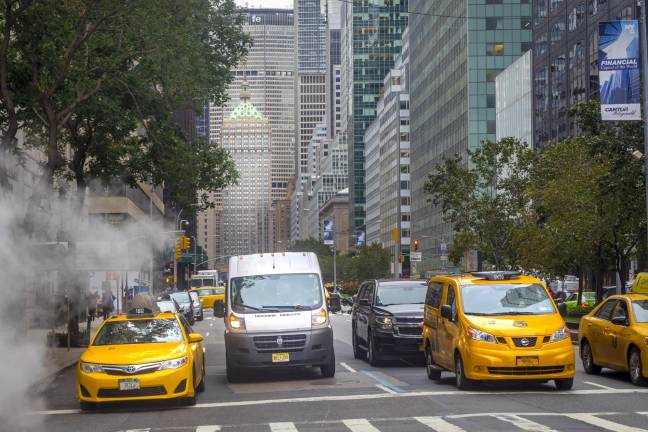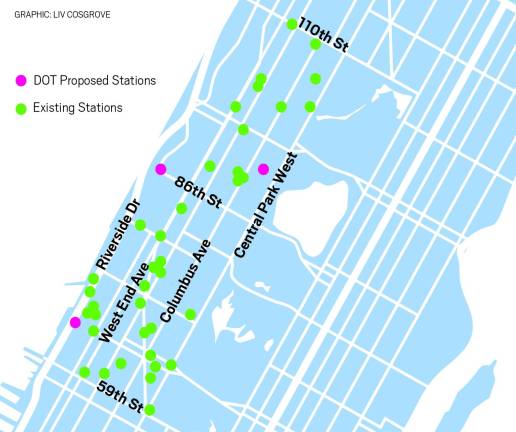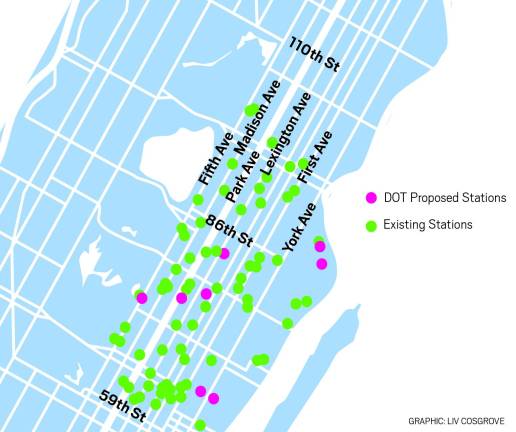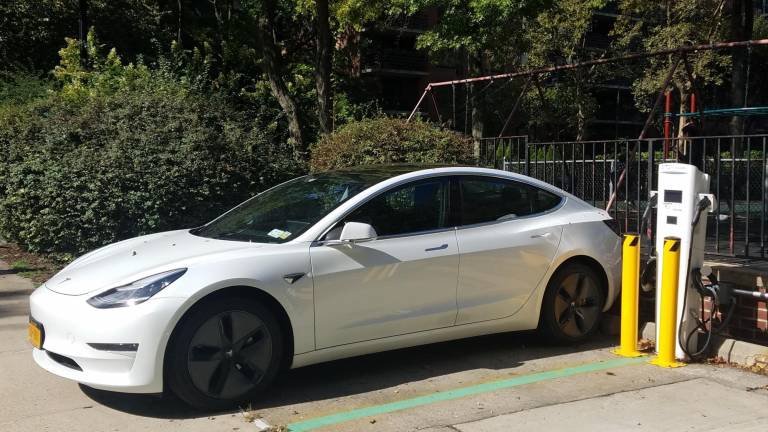At least 72 alternative fueling stations for plug-in electric cars are up and running on the East Side between 59th and 110th Streets, according to a Straus News review of federal data.
In the same 51-block stretch of the West Side, there are 40-plus electric vehicle charging stations in operation, the filings with the U.S. Dept. of Energy show.
Meanwhile, between the Battery and 59th Street, there are at least 240 places where owners of the roughly 30 EV models now on the market can go to juice up.
Those 350-plus stations, many hosting multiple charging ports, are new to the cityscape: The vast majority bowed in the past five years – even as the footprint of the old-fangled gas station shrank dramatically in a trend expected to pick up steam.
Almost all of them are located in public parking garages, in mixed-use complexes like the Time Warner Center or on the private grounds or below-grade garages of co-ops and condos.
Curbside Service
Now, the city is poised to introduce low-carbon fueling to a new realm: The streets of Manhattan.
In two detailed presentations – to Community Board 7 on the Upper West Side on Sept. 10 and Community Board 8 on the Upper East Side on Sept. 4 – the de Blasio administration unveiled a pilot program in which 50 electric chargers for public use will be installed at curbside sites across all five boroughs.
That includes eight on the UES and three on the UWS, as well as two in Washington Heights, with each charger bearing two separate ports that can electrify two cars simultaneously – and each occupying two parking spaces.
Bottom line for many residents: Yes, carbon-dioxide emissions will diminish. But so will parking spots. A total of 12 spaces on the East and West Sides will be taken out of circulation. Permanently.
In a public-private partnership with Con Edison, which is paying design and installation costs, the city’s Dept. of Transportation says it expects to finalize exact locations by the end of the year. It will then begin to build the stations by the spring of 2020.
But that’s just the beginning: In the briefing to CB 7, DOT officials said the four-year demonstration project, in addition to fostering expansion of EV ownership and curbing the internal combustion engine’s primacy, could pave the way for an ambitious, far-reaching build-out of curbside charging down the road.
The Decarbonization of Manhattan
“It’s coming soon to your neighborhood!” said Mark Simon, advisor on electric vehicle policy for the agency.
Designed to slash the city’s greenhouse gas emissions and promote renewable energy and climate-smart practices, the pilot program builds on the pioneering efforts of one co-op and one condo downtown.
The Seward Park Co-op on the Lower East Side first installed four electric charging stations on its grounds in 2011, and by 2013, the Solaire, a condominium in Battery Park City, opened two in its garage on Murray Street.
As electric battery ranges increased, and costs decreased, scores of public parking garages followed suit. By 2017, the private UN garage under the Secretariat Building had been outfitted, and more recently, the outdoor lot at the Vaux Condominium, at 372 Central Park West in Park West Village, was graced with three electric chargers.
Now, there are over 2,900 EVs in Manhattan, a registration tally that’s roughly doubled over the past six years. At least two or three times that number roll across the borough every day. The fleet includes the Tesla, Ford Focus, Nissan Leaf, Chevrolet Bolt and some two dozen other models.
Politically, the timing of the city’s new program could be propitious: Electrifying transportation, and swiftly purging gas-guzzlers, has become a Democratic presidential campaign centerpiece for Joe Biden, Bernie Sanders, Elizabeth Warren and Kamala Harris, not to mention Mayor Bill de Blasio himself.
And global attention will be focused on the urgent need to shed fossil fuels when the United Nations General Assembly convenes its 74th session on Sept. 17 and holds a Climate Change Action Summit on Sept. 23.
Questions About Parking and Practicality
But that doesn’t mean there won’t be resistance closer to home.
“Parking spaces are already being squeezed,” said Alida Camp, chair of CB 8. “We’re losing them on a regular basis – to bus lanes, bike lanes, turning lanes, CitiBike stations, 12-hour commercial parking zones – and it will be that many more cars circling around the neighborhood.”
Camp said she applauds the city’s effort to promote electric vehicles, but noting that it can take four to eight hours before a full charge is complete, questions the practicality of the plan.
“You have to park twice, first at the charging station, and then, after you charge, you have to park all over again elsewhere on the street, meaning you’ll always be driving around looking for parking spots,” she said. “It’s well intentioned, but there are an awful lot of kinks.”
A DOT spokesperson said a customer pays for a charge through an app. The car can safely be left unattended as it charges, without risk of theft or vandalism, because the connecting cord from the electric charger is locked into the vehicle via the app, and only the person who is charging up can remove it.
The app then notifies the customer once a charging event is complete, there’s an unspecified grace period before the EV has to be moved, and then charges begin to incur if the vehicle remains plugged in for too long, the DOT official said.
Meanwhile, with some reservations, the Transportation Committee of CB 7, by a 6-to-1 margin, passed a resolution supporting the city’s pilot program.
“We’re not happy because our No. 1 priority remains public transportation,” said Roberta Semer, chair of CB 7.
“While we’re endorsing this program, in an ideal world, we’d prefer a very limited number of cars,” she added. “But we don’t live in a perfect world, and so an electric car is many, many times more preferable than a gas car.”
Felicia Tunnah, DOTs deputy director of intergovernmental affairs at DOT, agreed. “If you have to drive a vehicle, we want to encourage you to drive an electric vehicle.”
invreporter@strausnews.com
“If you have to drive a vehicle, we want to encourage you to drive an electric vehicle.”
Felicia Tunnah, city’s Dept. of Transportation



